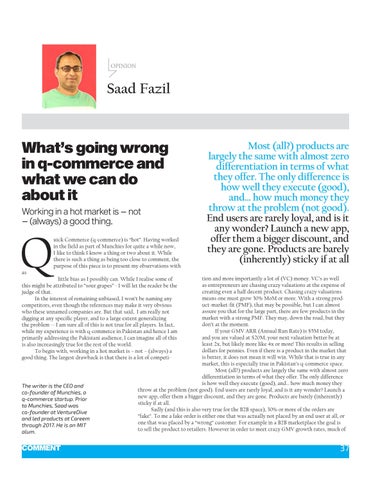OPINION
Saad Fazil
What’s going wrong in q-commerce and what we can do about it Working in a hot market is – not – (always) a good thing.
Q
uick Commerce (q-commerce) is “hot”. Having worked in the field as part of Munchies for quite a while now, I like to think I know a thing or two about it. While there is such a thing as being too close to comment, the purpose of this piece is to present my observations with
as
Most (all?) products are largely the same with almost zero differentiation in terms of what they offer. The only difference is how well they execute (good), and… how much money they throw at the problem (not good). End users are rarely loyal, and is it any wonder? Launch a new app, offer them a bigger discount, and they are gone. Products are barely (inherently) sticky if at all
tion and more importantly a lot of (VC) money. VC’s as well as entrepreneurs are chasing crazy valuations at the expense of creating even a half decent product. Chasing crazy valuations means one must grow 30% MoM or more. With a strong product-market-fit (PMF), that may be possible, but I can almost assure you that for the large part, there are few products in the market with a strong PMF. They may, down the road, but they don’t at the moment. If your GMV ARR (Annual Run Rate) is $5M today, and you are valued at $20M, your next valuation better be at least 2x, but likely more like 4x or more! This results in selling dollars for pennies. Even if there is a product in the market that is better, it does not mean it will win. While that is true in any market, this is especially true in Pakistan’s q-commerce space. Most (all?) products are largely the same with almost zero differentiation in terms of what they offer. The only difference is how well they execute (good), and… how much money they throw at the problem (not good). End users are rarely loyal, and is it any wonder? Launch a new app, offer them a bigger discount, and they are gone. Products are barely (inherently) sticky if at all. Sadly (and this is also very true for the B2B space), 30% or more of the orders are “fake”. To me a fake order is either one that was actually not placed by an end user at all, or one that was placed by a “wrong” customer. For example in a B2B marketplace the goal is to sell the product to retailers. However in order to meet crazy GMV growth rates, much of
little bias as I possibly can. While I realise some of this might be attributed to “sour grapes” - I will let the reader be the judge of that. In the interest of remaining unbiased, I won’t be naming any competitors, even though the references may make it very obvious who these unnamed companies are. But that said, I am really not digging at any specific player, and to a large extent generalizing the problem -- I am sure all of this is not true for all players. In fact, while my experience is with q-commetce in Pakistan and hence I am primarily addressing the Pakistani audience, I can imagine all of this is also increasingly true for the rest of the world. To begin with, working in a hot market is – not – (always) a good thing. The largest drawback is that there is a lot of competi-
The writer is the CEO and co-founder of Munchies, a q-commerce startup. Prior to Munchies, Saad was co-founder at VentureDive and led products at Careem through 2017. He is an MIT alum.
COMMENT
37
